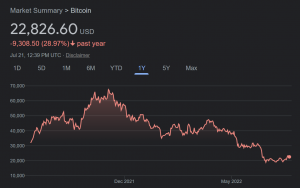
Cryptocurrencies seem to have hit a rough patch after riding a wave of success for years. Cryptos suffered heavy losses in the aftermath of the Russian invasion of Ukraine that saw all major currencies depreciating against the dollar. Though the digital currency market witnessed a gain on Tuesday after a month of record lows, investors across the world are still struggling to recover from the thrashing they received since early June.
The week saw major cryptocurrencies such as Bitcoin, Ethereum, Dogecoin and Solana recording major gains. The question is: how long can cryptocurrencies dodge the fall? In a major setback to crypto investors, electric car manufacturer Tesla said in its latest earnings report that it has shed around three-fourths of its Bitcoin investment. The car manufacturer had said last year that it has invested $1.5 billion in Bitcoin. In March 2021, Tesla’s maverick CEO Elon Musk tweeted that the company will accept bitcoin as payment for Tesla cars, which led to a crypto rally.
ALSO READ: Explained: Green hydrogen becomes cheaper than LNG in Europe
Cryptocurrencies and India
Investors across the world lapped up cryptocurrencies ever since Bitcoin made its entry. The digital currency managed to capture the headlines and investor attention in no time. While cryptocurrency obsession is real, the government of India has not been that enamoured with the prospect of digital currencies in its financial ecosystem. However, it has announced plans to introduce an official cryptocurrency.
Finance Minister Nirmala Sitharaman said last week that the Reserve Bank of India (RBI) has asked the government to frame regulations for cryptocurrencies, considering their destabilising effect on the monetary and fiscal stability of the country. This is an indication of the monetary authority’s apprehensions over the cryptocurrency fever. However, the government realises that it will need international collaboration to regulate or ban digital currencies since they are borderless. Meanwhile, everyone awaits the government’s much-anticipated crypto consultation paper which was expected in May 2022.

In India, the big confusion is over the classification of cryptocurrencies. The authorities are not sure if they are financial assets or some other category like commodities. The government has so far refused to make its stance on crypto public. It is pinning its hopes on the proposed India-made currency and expects that it will end the need for private digital currencies.
The year 2021 was a watershed one for digital currencies in the second-most-populous country in the world. Despite the government’s apprehensions, the purchase of cryptocurrencies was legalised by the Union Budget of 2022, although with a hefty tax rate of 30%. In fact, it was expected that India will be a major player in the global crypto market.
The world of digital currencies recently faced another blow as Singapore-based trading platform Vauld suspended operations recently. The platform was founded by two Indians — Darshan Bathija and Sanju Kurian — and its suspension has left its mostly Indian userbase in the lurch. The failure of Vauld comes on the heels of platforms such as US-based Celsius Network and Voyager Digital which also suspended trade, weakening trust in the cryptocurrency ecosystem.
ALSO READ: ONDC: Can govt’s e-commerce platform emulate UPI success
Collapses such as these strengthen the argument against legitimising cryptos. The RBI has been a vocal critic against digital currencies. RBI Governor Shaktikanta Das has, on many occasions, stressed on the fact that anything that derives its value from make-believe cannot stay in the long run. As many as 15-20 million Indians currently have their money invested in digital currencies which translates into a whopping $6 billion in investments in cryptos.
The rise and fall of cryptocurrencies
The number of cryptocurrencies today is more than thrice of what it was at the end of 2019. Those who invested in Bitcoin, Ethereum and other leading cryptocurrencies in their early years have minted money. The crazy pace at which cryptocurrencies have gained is evident from the fact that Bitcoin, the first cryptocurrency, was worthless when it came out in 2009. Cut to early 2022: a single bitcoin was worth more than $39,000. Bitcoin is now trading at $22,826, down nearly 29% from the past year.
The push towards digital currency has been so strong that the Fed has been discussing the pros and cons of issuing its own digital currency while China has already launched its own sovereign digital yuan and is testing on a limited basis.
The current year, however, is not a great one for the digital currency market. By early 2022, crypto prices had crashed from their peaks in late 2021. The timings couldn’t have been worse for Indian investors who were already reeling under the government-imposed 30% tax on the proceeds from crypto trading.
All cryptocurrencies are extremely volatile and a highly speculative bet, making it pertinent for all investors to exercise caution. Investors and everyday money users alike don’t want to get caught holding a worthless asset and the concerns regarding the fall of cryptocurrencies become real especially in the wake of fears of a global recession and skyrocketing inflation.
A piecemeal approach towards cryptocurrency regulation will not work as the number of cryptocurrencies has touched 18,142 and there are 460 crypto-exchanges. Economists world over are worried about the macroeconomic impact of cryptocurrencies as their total value is $1.7 trillion, with a daily trade volume in excess of $90 billion.

